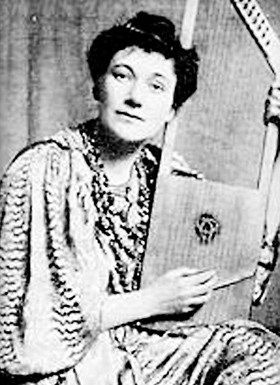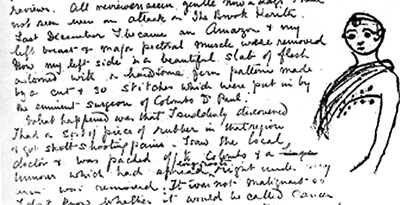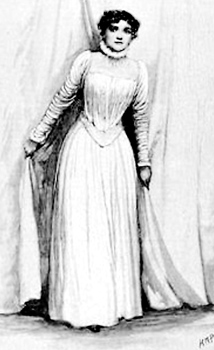From poets’ muse to principal in Jaffna
In February 1917, William Butler Yeats received a letter from a close female friend living in Ceylon and wept after reading its contents. “Last December I became an Amazon and my left breast and pectoral muscle were removed. Now my left side is a beautiful slab of flesh adorned with a handsome fern pattern made by a cut and thirty stitches which were ‘put in’ by the eminent surgeon of Colombo, Dr [Samuel Chelliah] Paul.”
The sender included a self-portrait: a sketch showing her mastectomy scar and Dr. Paul’s sutures. Dr Paul, a member of one of the country’s most renowned families dedicated to medicine, was then senior surgeon at the General Hospital, Colombo, and president of the Ceylon Medical Association (also president of the Royal Asiatic Society and chairman of the Ceylon Planters’ Association). But Dr. Paul’s skill could not save his patient, for the cancer had spread, and she died on April 29, 1917, at the General Hospital, aged 56.
It was a lonely end for someone who, before migrating to Ceylon, had been a pioneering West End actress, head of a notorious magical order, theosophist, ardent women’s rights activist, singer, musician, writer of both fiction and philosophy, and educator. In addition, she was a friend of, and collaborator with, not only Yeats, but George Bernard Shaw (with whom she had a relationship), Ezra Pound, Oscar Wilde, Aubrey Beardsley and other notables of London’s turn of the 20th-century era. She was a woman who inspired remarkable men. She was a classic ‘bohemian’s bohemian’. She was Florence Farr.

Florence strumming her psaltery harp (1903). Pictures courtesy wikipedia.org
While Florence lived out her final weeks at the General Hospital she had one friend and spiritual companion at her side, Sir Ponnambalam Ramanathan, whom she met through theosophy and was impressed by his plans for the education of young women in Ceylon. When Ramanathan established the Uduvil Ramanathan Girls College in 1912 she accepted his invitation to become principal, sold her possessions, and travelled to Jaffna. Yeats believed she made the journey to Ceylon because she feared losing her beauty, as expressed in his poem “All Souls’ Night”:
Who finding the first wrinkles on a face
Admired and beautiful,
And by the foreknowledge of the future vexed;
Diminished beauty, multiplied commonplace;
Preferred to teach a school
Away from neighbour or friend,
Among dark skins, permit foul years to wear
Hidden from eyesight to the unnoticed end.
Others thought she knew she had cancer, but the most likely reason, as noted by Kumari Jayawardena in The White Woman’s Other Burden: Western Women and South Asia during British Colonial Rule (1995), is that “she had reached the end of a phase and was prepared to embark on a new adventure”. Whatever, upon her death she was cremated and Ramanathan scattered her ashes on the Kelani Ganga.
Of plays, players and playwrights
Florence Beatrice Farr and I share the same birthplace, Bickley, a residential area in south-east London. She was born on July 7, 1860, the youngest of eight children of Mary Elizabeth Whittal and Dr. William Farr, one of England’s first sanitary reformers. He was a colleague of Florence Nightingale and named his daughter after her. An advocate of equal education and professional rights for women, he no doubt stimulated her feminist attitudes.
In 1873 Florence started school at the renowned Cheltenham Ladies’ College, and from 1877 to 1880 attended Queen’s College, London. The latter institution was the first in the world to award academic qualifications to women, and it had a distinctly liberal ethos, yet Florence was in revolt against any kind of institutionalized education.
So it is a surprise to learn that after graduation she became a teacher, but not surprising that she soon became disillusioned. She was drawn to the stage. Her early acting experience was in amateur productions with London’s Bedford Park Dramatics Club, in which her sister Henrietta and brother-in-law Henry Paget – a painter and stage designer – were members. Then in 1882 Florence served an apprenticeship under the actor-manager J.L. Toole at the Folly Theatre, where the careers of many prominent actors of that era began.
In deference to her father, who did not want the Farr name in its female personification associated with the theatre, she adopted the stage name Mary Lester. In April 1883, however, her father died, and she became Florence Farr in May when she began to perform at the Gaiety Theatre. She enjoyed modest success, but when she married actor Edward Emery in 1884 he insisted she quit the stage, which fuelled her feminist tendency.
In 1888, Emery departed for an extended tour of America and they never met again. Florence obtained a divorce in 1895 on the grounds of abandonment. Of interest is that Emery was married to the flamboyant, notorious, deep-voiced actress Tallulah Bankhead between 1937 and 1941.
In 1890 Florence moved in with Henrietta and Henry Paget at Bedford Park, an artistic enclave known for its free-thinkers and examples of the “New Woman” – a feminist, educated, independent career woman – the concept of George Bernard Shaw. Within such a milieu Florence swiftly became a “New Wave” feminist.
At Bedford Park Clubhouse, Florence starred in John Todhunter’s play A Sicilian Idyll: A Pastoral Play in Two Scenes (1890) as the Priestess Amaryllis. Both Shaw and Yeats were in the audience to review the play and were infatuated by Florence, who was blessed with a commanding appearance and beautiful voice. Shaw wrote of her “startling beauty, large expressive eyes, crescent eyebrows, and luminous smile”.
For Yeats, however, she was a Muse, her voice perfect for the recitation of his poetry. In his review of A Sicilian Idyll, he wrote that Florence “won universal praise with her striking beauty and subtle gesture and fine delivery of the verse . . . I do not know that I have any word too strong to express my admiration for its grace and power . . . I have never heard verse better spoken.”

Letter to Yeats in which Florence illustrates her mastectomy
Florence enjoyed a lengthy collaboration with Yeats on the chanted recitation of his poetry accompanied by a stringed instrument, the psaltery or hand-harp. In W.B. Yeats and the Muses (2010), Joseph M. Hassett explores how nine women, including Florence, inspired much of Yeats’ poetry. Hassett also emphasizes Florence’s contribution to Yeats’ emerging interest in the theatre as a medium of artistic expression.
One woman with a Ceylon connection missing from the list is Augusta, Lady Gregory, wife of Sir William Gregory, Governor of the colony from 1872 to 1877. An Irish dramatist, folklorist and theatre manager, she worked closely with Yeats for over forty years. However, according to Hassett she was “not a Muse” since “there is no indication that Yeats was erotically attracted to Gregory”.
Florence and Shaw became lovers in 1891 and she acted in his first play, Widower’s Houses (1892). He wanted to shape her as his idealized vision of the “New Woman” and be the star of his plays. However, Ibsen’s “new women” were popular then and in 1891 Florence appeared in the English premiere of the Norwegian dramatist’s Rosmersholm (1886), coached by Shaw for the part of the emancipated Rebecca West, which gained her critical acclaim. There followed the leading role of Blanche in Shaw’s first play, Widower’s Houses (1892), one of several that did not entertain but raised awareness of social issues.
In 1893, producer Annie Horniman financed Florence’s first venture as a director, a season of plays at the Avenue Theatre. She commissioned Aubrey Beardsley to create a poster and asked Shaw and Yeats to write the plays. Yeats delivered the The Land of Heart’s Desire, the first of his plays to be staged. But Shaw was unable to finish his play in time, so Todhunter’s A Comedy of Sighs was substituted, with Florence in the leading role, but the play was badly received.

Henry Paget’s illustration of Florence as Rebecca West in Ibsen’s Rosmersholm
Florence sent a desperate cable to Shaw, who finally delivered his masterpiece Arms and the Man. Her performance in Todhunter’s play had been atrocious so Shaw demoted her from the lead role of Raina to the supporting role of Louka, the vivacious and insolent servant girl. The play, a bold satire, was a great success with both audiences and critics. But Florence was growing closer to Yeats: Arms and the Man was the last of Shaw’s plays in which she performed.
In Yeats’ play, The Countess Cathleen (1899), a drama in blank verse with some lyrics, Florence portrayed Aleel, a minstrel possessing the ability to peer into the spirit world. She sang her lines in verse, while playing her psaltery and also organized the production and rehearsed the actors. But she knew her stage career was nearing its end.
The Order of the Golden Dawn
Michael Holroyd relates in Bernard Shaw Vol. II, 1898-1918, The Pursuit of Power (1989): “Florence, like Yeats, had been caught up in the epidemic of occultism overtaking Western religion. She had looked into Egyptology and Babylonish lore, hovered over astral projections, investigated alchemy . . . practised the hermetic arts; and was about to be promoted to Praemonstratrix in the ineffable Order of the Golden Dawn.”
Florence’s decade-long encounter with the Order of the Golden Dawn is a major aspect of her biography once she lost interest in becoming the great actress Shaw and Yeats envisaged. She was initiated into the Isis-Urania Temple of the Order in 1890 and chose the motto Sapienta Sapienti Dono Data, “wisdom is a gift given to the wise”. Soon she became only the second person in the Order to be initiated through the 5=6 ritual. By 1892 she was elevated to the status of Praemonstratrix (“Thou who art the First and the Last”), and revised some of the rituals of the Order. Yeats stated that no one could evoke in rituals the kind of shivers that Florence did by her resonant and commanding voice.
In 1897 Florence became the Chief Adept in England of the Order, but administrative and personality conflicts led to her resignation in 1902. It’s remarkable she gained a higher rank than, for example, the arch-occultist Aleister Crowley, the “Great Beast 666”. Captivated by Florence, Crowley based the character of Soror Cybele in his novel Moonchild (1917) on her. Whether or not they had an affair has been the subject of debate. But despite Crowley’s magical abilities she denied him his 5=6 advancement for “sex-intemperance” (an understatement).
Florence was a prolific writer, especially on esoteric subjects, but also created novels based on her life experiences such as The Dancing Faun (1894). Music of Speech (1909) is about her (and Yeats’) approach of applying musical notes to poetry for recitals. The Way of Wisdom (2001) endeavours to link the mystical significance of the Hebrew alphabet with Oriental traditions. Egyptian Magic (1896) is also worthy of study.
She went to Jaffna
And they wanted more from their women,
Wanted ‘em jacked up a little
And sent over for teachers (Ceylon)
So Loica [Louka] went out and died there
After her time in the post-Ibsen movement.
Ezra Pound on Florence Farr (Canto xxviii)
For this local section of biography I am greatly indebted to Kumari Jayawardena, whose book The White Woman’s Other Burden (1995) contains the best interpretation of why Florence ended up in Ceylon. Jayawardena states that Florence became “disillusioned by her British lovers and friends and bitterly remarked that, ‘half-baked people like Yeats and Shaw have tremendous influence and yet they only tell half-truths’. The whole truth, she began to feel, was in the East and she sought the company of Indians and Sri Lankans.”
In the early 20th century there were many intellectual Asians in London, including Sir Ponnambalam Ramanathan, who in 1902 addressed a meeting of those interested in eastern philosophy at which Florence was present. She pronounced that Christ had arisen and was working through Ramanathan. Then she immersed herself “in Eastern meditations and the study of pamphlets written by Ramanathan”, as Josephine Johnson reports in Florence Farr: Bernard Shaw’s New Woman (1975).
The result was, as Jayawardena wryly observes, that “Ramanathan returned the compliment by inviting her to Jaffna”. To prepare for her work as principal, Florence returned to Cheltenham Ladies’ College for a month to learn new educational methods such as the Montessori system, which she decided to introduce in Jaffna. Florence arrived in Colombo in October 1912 and stayed in Ramananthan’s house studying Tamil and meeting with officials of the Department of Education. She then travelled to Jaffna for the opening in 1913 of Uduvil Ramanathan Girls College.
“The people of Jaffna, of course, where kept unaware that the respectable ‘Lady Principal’ Mrs Florence Emery, was Florence Farr, the actress with a lively past,” Jayawardena comments. “But even if they knew, they might have accepted her as a ‘good woman’ because she was involved in Hindu girls’ education.”
Florence acquired total authority at the college as Lady Principal, supervising the teachers, the care of sick children, the minor staff, and general administration. No doubt the organizational skills she learned as the Praemonstratrix of the Golden Dawn served her well. Most important was her tolerance and respect for Tamil traditions. She also maintained some links with the past, especially Yeats, sending him her translations of Tamil poetry.
After just three years Florence became “unenthusiastic in her role of Lady Principal and resigned in 1916, but not wanting to leave Jaffna, she decided to stay on in the College as bursar, with a salary of Rs 60 a month.” However she soon fell ill and travelled to Colombo to consult, fittingly, Dr Lucian de Zilwa, whose between-consultations contribution to Sri Lankan theatre was immense. “He recognized her as the actress on the London stage he had ardently admired when he was a student. The wheel had come full circle.”
Jayawardena believes that the many roles Florence played in her life led to misidentification. “As a suffragist, socialist, actress and a ‘new woman’ she appealed to Shaw, but then she transformed herself into an occultist, spiritualist, and theosophist, much to Shaw’s annoyance and Yeats’ delight. But rejecting them both, she turned towards Ramanathan, the Hindu guru, only to find that his ideal role for Hindu women was only that of a wife and mother.”
“And in Sri Lanka she was again badly misrepresented, Ramanathan deliberately erased her past and she had to act the role of respectable lady principal and school administrator.” Moreover, “some of the remarkable men in her life ignored her feminist and similar attributes.”
Holroyd (1989) writes that thirty years after Florence’s death Shaw read her biography in the Ceylon Daily News [J Padmanabha, “In Memoriam Florence Farr Emery: The life and death of a Victorian Cleopatra”, April 30, 1947] and “confessed himself astonished. ‘I thought Yeats and I knew her through and through, as far as there was anything to know,’ he wrote. ‘I now see that we did not know her at all.’ To Yeats she had appeared to move ‘upwards out of life’ to her ‘unnoticed end’. From both her Irishmen she learnt little; or else she had mislearned. But Shaw had no doubt that Pannamballam [sic] Ramanathan had ‘opened her mind and developed the real woman. I should have said she was the last woman on earth to become the authoritative head of a college, or break her way out of the little cliques in which she figured in London, and find a spiritual home in philosophic India. I was wrong.’”
This is quite an admission by Shaw, who had been so opposed to Florence’s involvement with occultism, theosophy, and her spiritual rapport with Ramanathan, urging her not to be “misled by sloppy lunatics” and mocking her and Egyptology in Caesar and Cleopatra (1898). Indeed in his eighteenth and last play, the political comedy On the Rocks (1933) Shaw created a pompous character partly based on Ramanathan called Sir Jafna Pandranath.
Shaw visited the island during the 1930s and stayed at the Galle Face Hotel. He is oft-quoted as having said: “Ceylon is the cradle of the human race because everybody there looks an original.” Apparently Shaw also stated that if he was not born in Ireland he would have wished to be born in Ceylon. Whether he made a visit to Uduvil I know not.
Epilogue
Prior to her departure to Ceylon in August 1912, Florence left her correspondence in a locked box, only to be opened after her death, with the playwright, journalist, critic and editor, Clifford Bax. These letters were published in 1941 in Florence Farr, Bernard Shaw and WB Yeats, edited by Bax, who wrote that they “show that she had too much personality to become a good actress. It seems she made the amateur’s mistake of acting to herself and not to the audience. As an author she obtained the same measure of recognition she had already obtained as an actress.”
He described her as “a woman who could inspire remarkable men” and predicted she would be remembered primarily on account of her friendships with renowned intellectuals of the period. Therein lies the problem. In Shaw’s and Yeats’ biographies, Florence is often relegated to a friendship footnote rather than hailed for her contribution to their work.
Although a little-known former British resident in Ceylon, she is undoubtedly one of the most extraordinary. Curiously, another member of the most extraordinary club was her fellow Golden Dawn member, Aleister Crowley, whose two visits to Ceylon I documented in this newspaper in October/November 1996. The first visit, in 1901, was to meet yet another member of the Golden Dawn, Allan Bennett – who happened to be the tutor of Ramanathan’s son – regarding the problems within the Order from which Florence was just about to flee . . .


